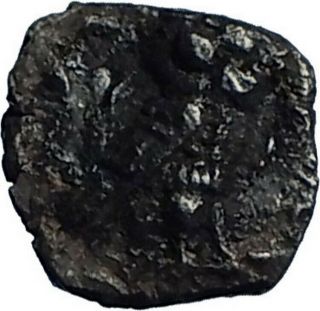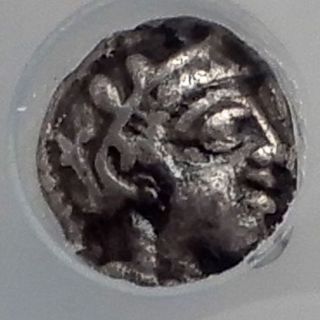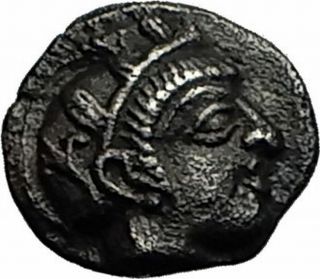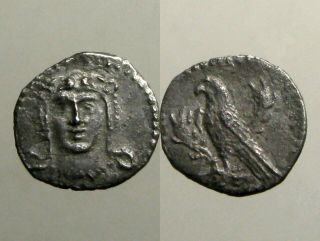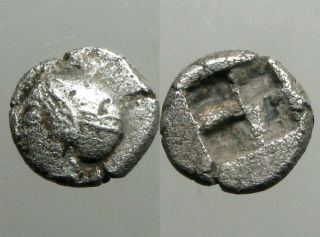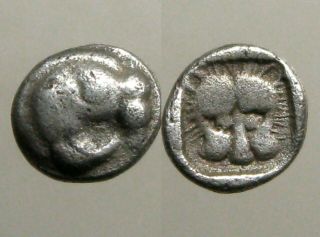ATHENS Greece Rare R2 475BC Silver OBOL Ancient Greek Coin ATHENA OWL I71673
Item History & Price
| Reference Number: Avaluer:58446848 | Culture: Greek |
| Composition: Silver | Coin Type: Ancient |
| Year: Year_in_description | Denomination: Obol |
Item: i71673
Authentic Ancient Coin of:Greek city of Athens in Attica Greece
Silver Obol 8mm (0.58 grams) Struck circa 475-465 B.C.
Reference: HGC 4, 1660-1663 Rare R2
Head of Athena in Attic helmet rightg.
Owl standing right, head facing; to right AΘE; to left, olive leaf to left; all within incuse square.You are bidding on the exact item pictured, provided with a Certificate of Authenticity and Lifetime Guarantee of Authenticity. Athena or Athene (Latin: Minerva)..., also referred to as Pallas Athena, is the goddess of war, civilization, wisdom, strength, strategy, crafts, justice and skill in Greek mythology. Minerva, Athena's Roman incarnation, embodies similar attributes. Athena is also a shrewd companion of heroes and the goddess of heroic endeavour. She is the virgin patron of Athens. The Athenians built the Parthenon on the Acropolis of her namesake city, Athens, in her honour (Athena Parthenos). Athena's cult as the patron of Athens seems to have existed from the earliest times and was so persistent that archaic myths about her were recast to adapt to cultural changes. In her role as a protector of the city (polis), many people throughout the Greek world worshiped Athena as Athena Polias ("Athena of the city"). Athens and Athena bear etymologically connected names.In Greek mythology, a Little Owl baby (Athene noctua) traditionally represents or accompanies Athena, the virgin goddess of wisdom, or Minerva, her syncretic incarnation in Roman mythology. Because of such association, the bird - often referred to as the "owl of Athena" or the "owl of Minerva" - has been used as a symbol of knowledge, wisdom, perspicacity and erudition throughout the Western world.Some authors believe that, in early times, Athena was either an owl herself or a bird goddess in general: In the third Book of the Odyssey, she takes the form of a sea-eagle. These authors argue that she dropped her prophylactic owl-mask before she lost her wings. "Athena, by the time she appears in art, " Jane Ellen Harrison had remarked, "has completely shed her animal form, has reduced the shapes she once wore of snake and bird to attributes, but occasionally in black-figure vase-paintings she still appears with wings.The modern West generally associates owls with wisdom. This link goes back at least as far as Ancient Greece, where Athens, noted for art and scholarship, and Athena, Athens' patron goddess and the goddess of wisdom, had the owl as a symbol. Marija Gimbutas traces veneration of the owl as a goddess, among other birds, to the culture of Old Europe, long pre-dating Indo-European cultures.Owls, birds of the order Strigiformes, include about 200 species of mostly solitary and nocturnal birds of prey typified by an upright stance, a large, broad head, binocular vision and binaural hearing, and feathers adapted for silent flight. Exceptions include the diurnal northern hawk-owl and the gregarious burrowing owl. Owls hunt mostly small mammals, insects, and other birds, although a few species specialize in hunting fish. They are found in all regions of the Earth except Antarctica and some remote islands. Owls are divided into two families: the true owls, Strigidae; and the barn-owls, Tytonidae.Athens is one of the oldest named cities in the world, having been continuously inhabited for at least 5000 years. Situated in southern Europe, Athens became the leading city of Ancient Greece in the first millennium BC, and its cultural achievements during the 5th century BC laid the foundations of western civilization.The city of Athens during the classical period of Ancient Greece (508-322 BC) was the major urban center of the notable polis (city-state) of the same name, located in Attica, Greece, leading the Delian League in the Peloponnesian War against Sparta and the Peloponnesian League. Athenian democracy was established in 508 BC under Cleisthenes following the tyranny of Isagoras. This system remained remarkably stable, and with a few brief interruptions remained in place for 180 years, until 322 BC (aftermath of Lamian War). The peak of Athenian hegemony was achieved in the 440s to 430s BC, known as the Age of Pericles.In the classical period, Athens was a center for the arts, learning and philosophy, home of Plato's Akademia and Aristotle's Lyceum, Athens was also the birthplace of Socrates, Pericles, Sophocles, and many other prominent philosophers, writers and politicians of the ancient world. It is widely referred to as the cradle of Western Civilization, and the birthplace of democracy, largely due to the impact of its cultural and political achievements during the 5th and 4th centuries BC on the rest of the then-known European continent.HistoryThe name of Athens, connected to the name of its patron goddess Athena, originates from an earlier Pre-Greek language. The etiological myth explaining how Athens acquired this name through the legendary contest between Poseidon and Athena was described by Herodotus, Apollodorus, Ovid, Plutarch, Pausanias and others. It even became the theme of the sculpture on the West pediment of the Parthenon. Both Athena and Poseidon requested to be patrons of the city and to give their name to it, so they competed with one another for the honour, offering the city one gift each. Poseidon produced a spring by striking the ground with his trident, symbolizing naval power.Athena created the olive tree, symbolizing peace and prosperity. The Athenians, under their ruler Cecrops, accepted the olive tree and named the city after Athena. (Later the Southern Italian city of Paestum was founded under the name of Poseidonia at about 600 BC.) A sacred olive tree said to be the one created by the goddess was still kept on the Acropolis at the time of Pausanias (2nd century AD). It was located by the temple of Pandrosus, next to the Parthenon. According to Herodotus, the tree had been burnt down during the Persian Wars, but a shoot sprung from the stump. The Greeks saw this as a symbol that Athena still had her mark there on the city.Plato, in his dialogue Cratylus, offers his own etymology of Athena's name connecting it to the phrase ἁ θεονόα or hē theoû nóēsis (ἡ θεοῦ νόησις, 'the mind of god').Classical AthensEarly Athenian military history and Persian eraPrior to the rise of Athens, Sparta considered itself to be the leader of the Greeks, or hegemon. In 499 BC, Athens sent troops to aid the Ionian Greeks of Asia Minor, who were rebelling against the Persian Empire (the Ionian Revolt). This provoked two Persian invasions of Greece (see Persian Wars). In 490 BC, the Athenians, led by the soldier-statesman Miltiades, defeated the first invasion of the Persians under Darius I at the Battle of Marathon.In 487 BC, the Persians returned under Darius's son Xerxes. When a small Greek force holding the pass of Thermopylae was defeated, the Athenians evacuated Athens, the city that was taken by the Persians. Athens got captured and sacked twice by the Persians within one year after Thermopylae. Subsequently, the Athenians (led by Themistocles), with their allies, engaged the much larger Persian navy at sea in the Battle of Salamis. Xerxes built a throne on the coast in order to watch the Greek navy being defeated, but instead, the Persians were routed. This established a great turning point in the war.In 479 BC, the Athenians and Spartans, with their allies, defeated the Persian army at the Battle of Plataea. However, it was Athens that took the war to Asia Minor. These victories enabled it to bring most of the Aegean and many other parts of Greece together in the Delian League, an Athenian-dominated alliance.Artists and philosophersThe period from the end of the Persian Wars to the Macedonian conquest marked the zenith of Athens as a center of literature, philosophy (Greek philosophy), and the arts (Greek theatre). In Athens at this time, the political satire of the Comic poets at the theatres had a remarkable influence on public opinion.Some of the most important figures of Western cultural and intellectual history lived in Athens during this period: the dramatists Aeschylus, Aristophanes, Euripides and Sophocles, the physician Hippocrates, the philosophers Aristotle, Plato and Socrates, the historians Herodotus, Thucydides and Xenophon, the poet Simonides, and the sculptor Phidias. The leading statesman of this period was Pericles, who used the tribute paid by the members of the Delian League to build the Parthenon and other great monuments of classical Athens. The city became, in Pericles's words, "the school of Hellas [Greece]."Peloponnesian WarThe resentment felt by other cities at the hegemony of Athens led to the Peloponnesian War, which began in 431 BC and pitted Athens and its increasingly rebellious overseas empire against a coalition of land-based states led by Sparta. The conflict ended with a victory for Sparta and the end of Athenian command of the sea. This civil war in Greece left the Greeks weak and divided leading to Philip II and Alexander the Great taking over Greece.Athenian coup of 411 BCThe democracy in Athens was briefly overthrown by a coup in 411 BC, due to its poor handling of the war, but it was quickly restored. The war ended in 404 BC with the complete defeat of Athens. Since the loss of the war was largely blamed on democratic politicians such as Cleon and Cleophon, there was a brief reaction against democracy, aided by the Spartan army (the rule of the Thirty Tyrants). In 403 BC, however, democracy was restored by Thrasybulus and an amnesty was declared.Corinthian War and the Second Athenian LeagueSparta's former allies soon turned against her, due to her imperialist policy, and soon Athens' former enemies Thebes and Corinth had become her allies; they fought with Athens and Argos against Sparta in the indecisive Corinthian War (395 - 387 BC). Opposition to Sparta enabled Athens to establish a Second Athenian League.Finally Thebes defeated Sparta in 371 BC in the Battle of Leuctra. But then the Greek cities (including Athens and Sparta) turned against Thebes, whose dominance was stopped at the Battle of Mantinea (362 BC) with the death of its military-genius leader Epaminondas.Athens under MacedonBy the mid-4th century BC, however, the northern Greek kingdom of Macedon was becoming dominant in Athenian affairs, despite the warnings of the last great statesman of independent Athens, Demosthenes. In 338 BC the armies of Philip II defeated an alliance of some of the Greek city-states including Athens and Thebes at the Battle of Chaeronea, effectively ending Athenian independence. Subsequently, the conquests of his son Alexander the Great widened Greek horizons and made the traditional Greek city state obsolete. Athens remained a wealthy city with a brilliant cultural life, but ceased to be a leading power.Roman AthensIn 88-85 BC, most Athenian buildings, both houses and fortifications, were leveled by the Roman general Sulla (138 BC - 78 BC), although many civic buildings and monuments were left intact. Under Rome, Athens was given the status of a free city because of its widely admired schools. The Roman emperor Hadrian, in the 2nd century AD, constructed a library, a gymnasium, an aqueduct which is still in use, several temples and sanctuaries, a bridge and financed the completion of the Temple of Olympian Zeus.The city was sacked by the Heruli in AD 267, resulting in the burning of all the public buildings, the plundering of the lower city and the damaging of the Agora and Acropolis. After this the city to the north of the Acropolis was hastily refortified on a smaller scale, with the Agora left outside the walls. Athens remained a centre of learning and philosophy during its 500 years of Roman rule, patronized by emperors such as Nero and Hadrian.The sack of the city by the Heruls in 267 and Alaric in 396, however, dealt a heavy blow to the city's fabric and fortunes, and Athens was henceforth confined to a small fortified area that embraced a fraction of the ancient city. The city remained an important center of learning, especially of Neoplatonism-with notable pupils including Gregory of Nazianzus, Basil of Caesarea and emperor Julian-and consequently a center of paganism. Christian items do not appear in the archaeological record until the early 5th century. The Emperor Justinian I closed down the city's philosophical schools in 529, an event whose impact on the city is much debated, but is generally taken to mark the end of the ancient history of Athens.Frequently Asked Questions
Mr. Ilya Zlobin, world-renowned expert numismatist, enthusiast, author and dealer in authentic ancient Greek, ancient Roman, ancient Byzantine, world coins & more.Who am I dealing with?You are dealing with Ilya Zlobin, ancient coin expert, enthusiast, author and dealer with an online store having a selection of over 15, 000 items with great positive feedback from verified buyers and over 10 years experience dealing with over 57, 000 ancient and world coins and artifacts. Ilya Zlobin is an independent individual who has a passion for coin collecting, research and understanding the importance of the historical context and significance all coins and objects represent. Most others are only concerned with selling you, Ilya Zlobin is most interested in educating you on the subject, and providing the largest selection, most professional presentation and service for the best long-term value for collectors worldwide creating returning patrons sharing in the passion of ancient and world coin collecting for a lifetime. How long until my order is shipped?Orders are shipped by the next business day (after receipt of payment) most of the time. How will I know when the order was shipped?After your order has shipped, you will be left positive feedback, and that date could be used as a basis of estimating an arrival date. Any tracking number would be found under your 'Purchase history' tab.USPS First Class mail takes about 3-5 business days to arrive in the U.S. International shipping times cannot be estimated as they vary from country to country.Standard international mail to many countries does not include a tracking number, and can also be slow sometimes. For a tracking number and signature confirmation, you may want to do Express Mail International Shipping, which costs more, however, is the fastest and most secure. Additionally you may be able to receive your order in as little as 3-5 business days using this method. For Express Mail International, it may be possible to place up to 10-15 items in one package (for the one shipping cost) as it is flat rate envelope, which may be the most cost-effective, secure and fastest way to receive items internationally. Send me a message about this and I can update your invoice should you want this method.Getting your order to you, quickly and securely is a top priority and is taken seriously here. Great care is taken in packaging and mailing every item securely and quickly.Please be aware, I cannot take responsibility for any postal service delivery delays, especially for international packages as it may happen in rare instances.What is a certificate of authenticity and what guarantees do you give that the item is authentic?Each of the items sold here, is provided with a Certificate of Authenticity, and a Lifetime Guarantee of Authenticity, issued by a world-renowned numismatic and antique expert that has identified over 57, 000 ancient coins and has provided them with the same guarantee. You will be very happy with what you get with the COA; a professional presentation of the coin, with all of the relevant information and a picture of the coin you saw in the listing. Additionally, the coin is inside it's own protective coin flip (holder), with a 2x2 inch description of the coin matching the individual number on the COA.On the free-market such a presentation alone, can be considered a $25-$50 value all in itself, and it comes standard with your purchases from me, FREE. With every purchase, you are leveraging my many years of experience to get a more complete context and understanding of the piece of history you are getting. Whether your goal is to collect or give the item as a gift, coins presented like this could be more prized and valued higher than items that were not given such care and attention to.Buy a coin today and own a piece of history, guaranteed.Is there a money back guarantee?I offer a 30 day unconditional money back guarantee. I stand behind my coins and would be willing to exchange your order for either store credit towards other coins, or refund, minus shipping expenses, within 30 days from the receipt of your order. My goal is to have the returning customers for a lifetime, and I am so sure in my coins, their authenticity, numismatic value and beauty, I can offer such a guarantee.When should I leave feedback?Once you receive your order, please leave a positive feedback. Please don't leave any negative feedbacks, as it happens sometimes that people rush to leave feedback before letting sufficient time for their order to arrive. Also, if you sent an email, make sure to check for my reply in your messages before claiming that you didn't receive a response. The matter of fact is that any issues can be resolved, as reputation is most important to me. My goal is to provide superior products and quality of service.How and where do I learn more about collecting ancient coins?Visit the "Guide on How to Use My Store" for on an overview about using my store, with additional information and links to all other parts of my store which may include educational information on topics you are looking for.
03034
Authentic Ancient Coin of:Greek city of Athens in Attica Greece
Silver Obol 8mm (0.58 grams) Struck circa 475-465 B.C.
Reference: HGC 4, 1660-1663 Rare R2
Head of Athena in Attic helmet rightg.
Owl standing right, head facing; to right AΘE; to left, olive leaf to left; all within incuse square.You are bidding on the exact item pictured, provided with a Certificate of Authenticity and Lifetime Guarantee of Authenticity. Athena or Athene (Latin: Minerva)..., also referred to as Pallas Athena, is the goddess of war, civilization, wisdom, strength, strategy, crafts, justice and skill in Greek mythology. Minerva, Athena's Roman incarnation, embodies similar attributes. Athena is also a shrewd companion of heroes and the goddess of heroic endeavour. She is the virgin patron of Athens. The Athenians built the Parthenon on the Acropolis of her namesake city, Athens, in her honour (Athena Parthenos). Athena's cult as the patron of Athens seems to have existed from the earliest times and was so persistent that archaic myths about her were recast to adapt to cultural changes. In her role as a protector of the city (polis), many people throughout the Greek world worshiped Athena as Athena Polias ("Athena of the city"). Athens and Athena bear etymologically connected names.In Greek mythology, a Little Owl baby (Athene noctua) traditionally represents or accompanies Athena, the virgin goddess of wisdom, or Minerva, her syncretic incarnation in Roman mythology. Because of such association, the bird - often referred to as the "owl of Athena" or the "owl of Minerva" - has been used as a symbol of knowledge, wisdom, perspicacity and erudition throughout the Western world.Some authors believe that, in early times, Athena was either an owl herself or a bird goddess in general: In the third Book of the Odyssey, she takes the form of a sea-eagle. These authors argue that she dropped her prophylactic owl-mask before she lost her wings. "Athena, by the time she appears in art, " Jane Ellen Harrison had remarked, "has completely shed her animal form, has reduced the shapes she once wore of snake and bird to attributes, but occasionally in black-figure vase-paintings she still appears with wings.The modern West generally associates owls with wisdom. This link goes back at least as far as Ancient Greece, where Athens, noted for art and scholarship, and Athena, Athens' patron goddess and the goddess of wisdom, had the owl as a symbol. Marija Gimbutas traces veneration of the owl as a goddess, among other birds, to the culture of Old Europe, long pre-dating Indo-European cultures.Owls, birds of the order Strigiformes, include about 200 species of mostly solitary and nocturnal birds of prey typified by an upright stance, a large, broad head, binocular vision and binaural hearing, and feathers adapted for silent flight. Exceptions include the diurnal northern hawk-owl and the gregarious burrowing owl. Owls hunt mostly small mammals, insects, and other birds, although a few species specialize in hunting fish. They are found in all regions of the Earth except Antarctica and some remote islands. Owls are divided into two families: the true owls, Strigidae; and the barn-owls, Tytonidae.Athens is one of the oldest named cities in the world, having been continuously inhabited for at least 5000 years. Situated in southern Europe, Athens became the leading city of Ancient Greece in the first millennium BC, and its cultural achievements during the 5th century BC laid the foundations of western civilization.The city of Athens during the classical period of Ancient Greece (508-322 BC) was the major urban center of the notable polis (city-state) of the same name, located in Attica, Greece, leading the Delian League in the Peloponnesian War against Sparta and the Peloponnesian League. Athenian democracy was established in 508 BC under Cleisthenes following the tyranny of Isagoras. This system remained remarkably stable, and with a few brief interruptions remained in place for 180 years, until 322 BC (aftermath of Lamian War). The peak of Athenian hegemony was achieved in the 440s to 430s BC, known as the Age of Pericles.In the classical period, Athens was a center for the arts, learning and philosophy, home of Plato's Akademia and Aristotle's Lyceum, Athens was also the birthplace of Socrates, Pericles, Sophocles, and many other prominent philosophers, writers and politicians of the ancient world. It is widely referred to as the cradle of Western Civilization, and the birthplace of democracy, largely due to the impact of its cultural and political achievements during the 5th and 4th centuries BC on the rest of the then-known European continent.HistoryThe name of Athens, connected to the name of its patron goddess Athena, originates from an earlier Pre-Greek language. The etiological myth explaining how Athens acquired this name through the legendary contest between Poseidon and Athena was described by Herodotus, Apollodorus, Ovid, Plutarch, Pausanias and others. It even became the theme of the sculpture on the West pediment of the Parthenon. Both Athena and Poseidon requested to be patrons of the city and to give their name to it, so they competed with one another for the honour, offering the city one gift each. Poseidon produced a spring by striking the ground with his trident, symbolizing naval power.Athena created the olive tree, symbolizing peace and prosperity. The Athenians, under their ruler Cecrops, accepted the olive tree and named the city after Athena. (Later the Southern Italian city of Paestum was founded under the name of Poseidonia at about 600 BC.) A sacred olive tree said to be the one created by the goddess was still kept on the Acropolis at the time of Pausanias (2nd century AD). It was located by the temple of Pandrosus, next to the Parthenon. According to Herodotus, the tree had been burnt down during the Persian Wars, but a shoot sprung from the stump. The Greeks saw this as a symbol that Athena still had her mark there on the city.Plato, in his dialogue Cratylus, offers his own etymology of Athena's name connecting it to the phrase ἁ θεονόα or hē theoû nóēsis (ἡ θεοῦ νόησις, 'the mind of god').Classical AthensEarly Athenian military history and Persian eraPrior to the rise of Athens, Sparta considered itself to be the leader of the Greeks, or hegemon. In 499 BC, Athens sent troops to aid the Ionian Greeks of Asia Minor, who were rebelling against the Persian Empire (the Ionian Revolt). This provoked two Persian invasions of Greece (see Persian Wars). In 490 BC, the Athenians, led by the soldier-statesman Miltiades, defeated the first invasion of the Persians under Darius I at the Battle of Marathon.In 487 BC, the Persians returned under Darius's son Xerxes. When a small Greek force holding the pass of Thermopylae was defeated, the Athenians evacuated Athens, the city that was taken by the Persians. Athens got captured and sacked twice by the Persians within one year after Thermopylae. Subsequently, the Athenians (led by Themistocles), with their allies, engaged the much larger Persian navy at sea in the Battle of Salamis. Xerxes built a throne on the coast in order to watch the Greek navy being defeated, but instead, the Persians were routed. This established a great turning point in the war.In 479 BC, the Athenians and Spartans, with their allies, defeated the Persian army at the Battle of Plataea. However, it was Athens that took the war to Asia Minor. These victories enabled it to bring most of the Aegean and many other parts of Greece together in the Delian League, an Athenian-dominated alliance.Artists and philosophersThe period from the end of the Persian Wars to the Macedonian conquest marked the zenith of Athens as a center of literature, philosophy (Greek philosophy), and the arts (Greek theatre). In Athens at this time, the political satire of the Comic poets at the theatres had a remarkable influence on public opinion.Some of the most important figures of Western cultural and intellectual history lived in Athens during this period: the dramatists Aeschylus, Aristophanes, Euripides and Sophocles, the physician Hippocrates, the philosophers Aristotle, Plato and Socrates, the historians Herodotus, Thucydides and Xenophon, the poet Simonides, and the sculptor Phidias. The leading statesman of this period was Pericles, who used the tribute paid by the members of the Delian League to build the Parthenon and other great monuments of classical Athens. The city became, in Pericles's words, "the school of Hellas [Greece]."Peloponnesian WarThe resentment felt by other cities at the hegemony of Athens led to the Peloponnesian War, which began in 431 BC and pitted Athens and its increasingly rebellious overseas empire against a coalition of land-based states led by Sparta. The conflict ended with a victory for Sparta and the end of Athenian command of the sea. This civil war in Greece left the Greeks weak and divided leading to Philip II and Alexander the Great taking over Greece.Athenian coup of 411 BCThe democracy in Athens was briefly overthrown by a coup in 411 BC, due to its poor handling of the war, but it was quickly restored. The war ended in 404 BC with the complete defeat of Athens. Since the loss of the war was largely blamed on democratic politicians such as Cleon and Cleophon, there was a brief reaction against democracy, aided by the Spartan army (the rule of the Thirty Tyrants). In 403 BC, however, democracy was restored by Thrasybulus and an amnesty was declared.Corinthian War and the Second Athenian LeagueSparta's former allies soon turned against her, due to her imperialist policy, and soon Athens' former enemies Thebes and Corinth had become her allies; they fought with Athens and Argos against Sparta in the indecisive Corinthian War (395 - 387 BC). Opposition to Sparta enabled Athens to establish a Second Athenian League.Finally Thebes defeated Sparta in 371 BC in the Battle of Leuctra. But then the Greek cities (including Athens and Sparta) turned against Thebes, whose dominance was stopped at the Battle of Mantinea (362 BC) with the death of its military-genius leader Epaminondas.Athens under MacedonBy the mid-4th century BC, however, the northern Greek kingdom of Macedon was becoming dominant in Athenian affairs, despite the warnings of the last great statesman of independent Athens, Demosthenes. In 338 BC the armies of Philip II defeated an alliance of some of the Greek city-states including Athens and Thebes at the Battle of Chaeronea, effectively ending Athenian independence. Subsequently, the conquests of his son Alexander the Great widened Greek horizons and made the traditional Greek city state obsolete. Athens remained a wealthy city with a brilliant cultural life, but ceased to be a leading power.Roman AthensIn 88-85 BC, most Athenian buildings, both houses and fortifications, were leveled by the Roman general Sulla (138 BC - 78 BC), although many civic buildings and monuments were left intact. Under Rome, Athens was given the status of a free city because of its widely admired schools. The Roman emperor Hadrian, in the 2nd century AD, constructed a library, a gymnasium, an aqueduct which is still in use, several temples and sanctuaries, a bridge and financed the completion of the Temple of Olympian Zeus.The city was sacked by the Heruli in AD 267, resulting in the burning of all the public buildings, the plundering of the lower city and the damaging of the Agora and Acropolis. After this the city to the north of the Acropolis was hastily refortified on a smaller scale, with the Agora left outside the walls. Athens remained a centre of learning and philosophy during its 500 years of Roman rule, patronized by emperors such as Nero and Hadrian.The sack of the city by the Heruls in 267 and Alaric in 396, however, dealt a heavy blow to the city's fabric and fortunes, and Athens was henceforth confined to a small fortified area that embraced a fraction of the ancient city. The city remained an important center of learning, especially of Neoplatonism-with notable pupils including Gregory of Nazianzus, Basil of Caesarea and emperor Julian-and consequently a center of paganism. Christian items do not appear in the archaeological record until the early 5th century. The Emperor Justinian I closed down the city's philosophical schools in 529, an event whose impact on the city is much debated, but is generally taken to mark the end of the ancient history of Athens.Frequently Asked Questions
Mr. Ilya Zlobin, world-renowned expert numismatist, enthusiast, author and dealer in authentic ancient Greek, ancient Roman, ancient Byzantine, world coins & more.Who am I dealing with?You are dealing with Ilya Zlobin, ancient coin expert, enthusiast, author and dealer with an online store having a selection of over 15, 000 items with great positive feedback from verified buyers and over 10 years experience dealing with over 57, 000 ancient and world coins and artifacts. Ilya Zlobin is an independent individual who has a passion for coin collecting, research and understanding the importance of the historical context and significance all coins and objects represent. Most others are only concerned with selling you, Ilya Zlobin is most interested in educating you on the subject, and providing the largest selection, most professional presentation and service for the best long-term value for collectors worldwide creating returning patrons sharing in the passion of ancient and world coin collecting for a lifetime. How long until my order is shipped?Orders are shipped by the next business day (after receipt of payment) most of the time. How will I know when the order was shipped?After your order has shipped, you will be left positive feedback, and that date could be used as a basis of estimating an arrival date. Any tracking number would be found under your 'Purchase history' tab.USPS First Class mail takes about 3-5 business days to arrive in the U.S. International shipping times cannot be estimated as they vary from country to country.Standard international mail to many countries does not include a tracking number, and can also be slow sometimes. For a tracking number and signature confirmation, you may want to do Express Mail International Shipping, which costs more, however, is the fastest and most secure. Additionally you may be able to receive your order in as little as 3-5 business days using this method. For Express Mail International, it may be possible to place up to 10-15 items in one package (for the one shipping cost) as it is flat rate envelope, which may be the most cost-effective, secure and fastest way to receive items internationally. Send me a message about this and I can update your invoice should you want this method.Getting your order to you, quickly and securely is a top priority and is taken seriously here. Great care is taken in packaging and mailing every item securely and quickly.Please be aware, I cannot take responsibility for any postal service delivery delays, especially for international packages as it may happen in rare instances.What is a certificate of authenticity and what guarantees do you give that the item is authentic?Each of the items sold here, is provided with a Certificate of Authenticity, and a Lifetime Guarantee of Authenticity, issued by a world-renowned numismatic and antique expert that has identified over 57, 000 ancient coins and has provided them with the same guarantee. You will be very happy with what you get with the COA; a professional presentation of the coin, with all of the relevant information and a picture of the coin you saw in the listing. Additionally, the coin is inside it's own protective coin flip (holder), with a 2x2 inch description of the coin matching the individual number on the COA.On the free-market such a presentation alone, can be considered a $25-$50 value all in itself, and it comes standard with your purchases from me, FREE. With every purchase, you are leveraging my many years of experience to get a more complete context and understanding of the piece of history you are getting. Whether your goal is to collect or give the item as a gift, coins presented like this could be more prized and valued higher than items that were not given such care and attention to.Buy a coin today and own a piece of history, guaranteed.Is there a money back guarantee?I offer a 30 day unconditional money back guarantee. I stand behind my coins and would be willing to exchange your order for either store credit towards other coins, or refund, minus shipping expenses, within 30 days from the receipt of your order. My goal is to have the returning customers for a lifetime, and I am so sure in my coins, their authenticity, numismatic value and beauty, I can offer such a guarantee.When should I leave feedback?Once you receive your order, please leave a positive feedback. Please don't leave any negative feedbacks, as it happens sometimes that people rush to leave feedback before letting sufficient time for their order to arrive. Also, if you sent an email, make sure to check for my reply in your messages before claiming that you didn't receive a response. The matter of fact is that any issues can be resolved, as reputation is most important to me. My goal is to provide superior products and quality of service.How and where do I learn more about collecting ancient coins?Visit the "Guide on How to Use My Store" for on an overview about using my store, with additional information and links to all other parts of my store which may include educational information on topics you are looking for.
03034




